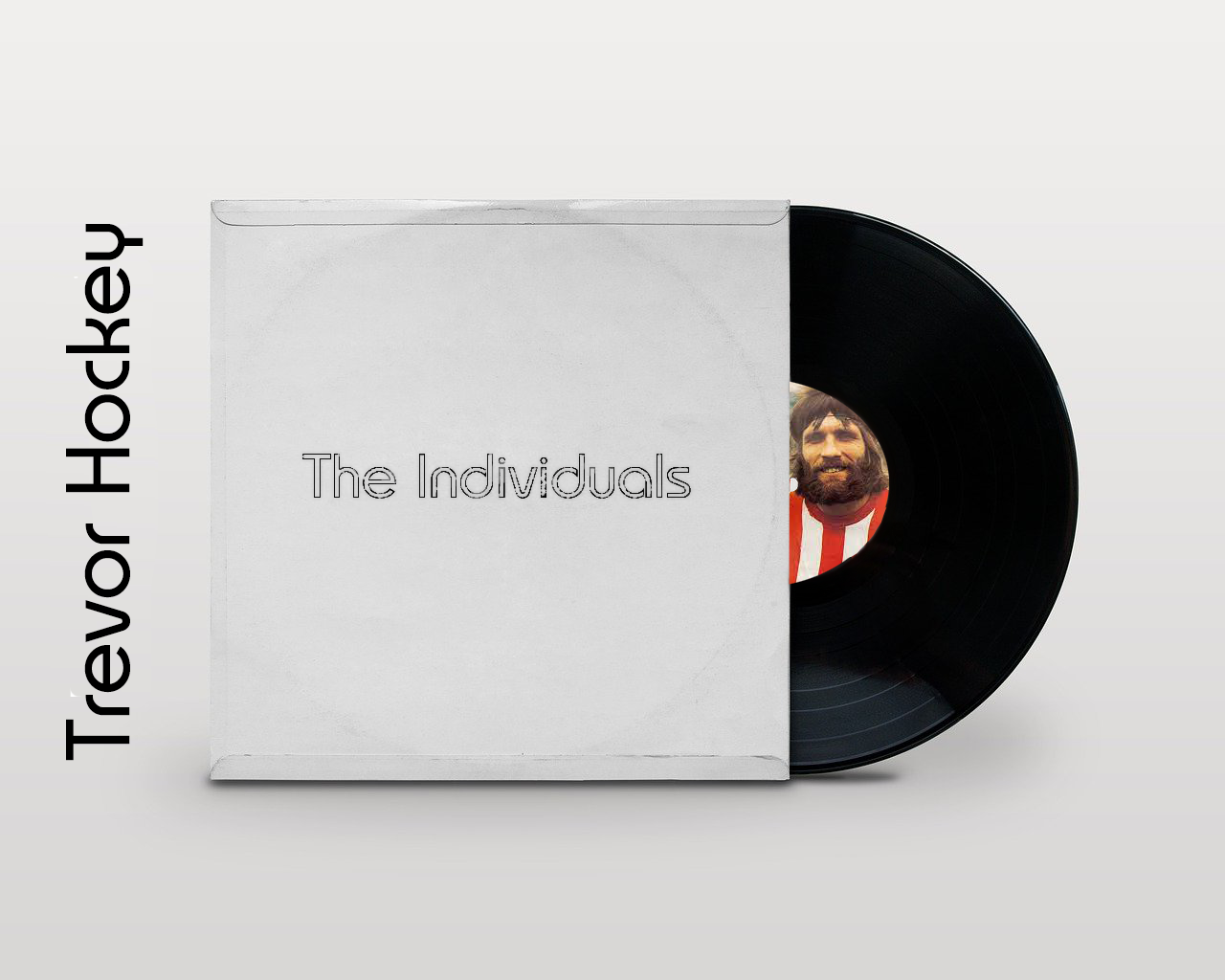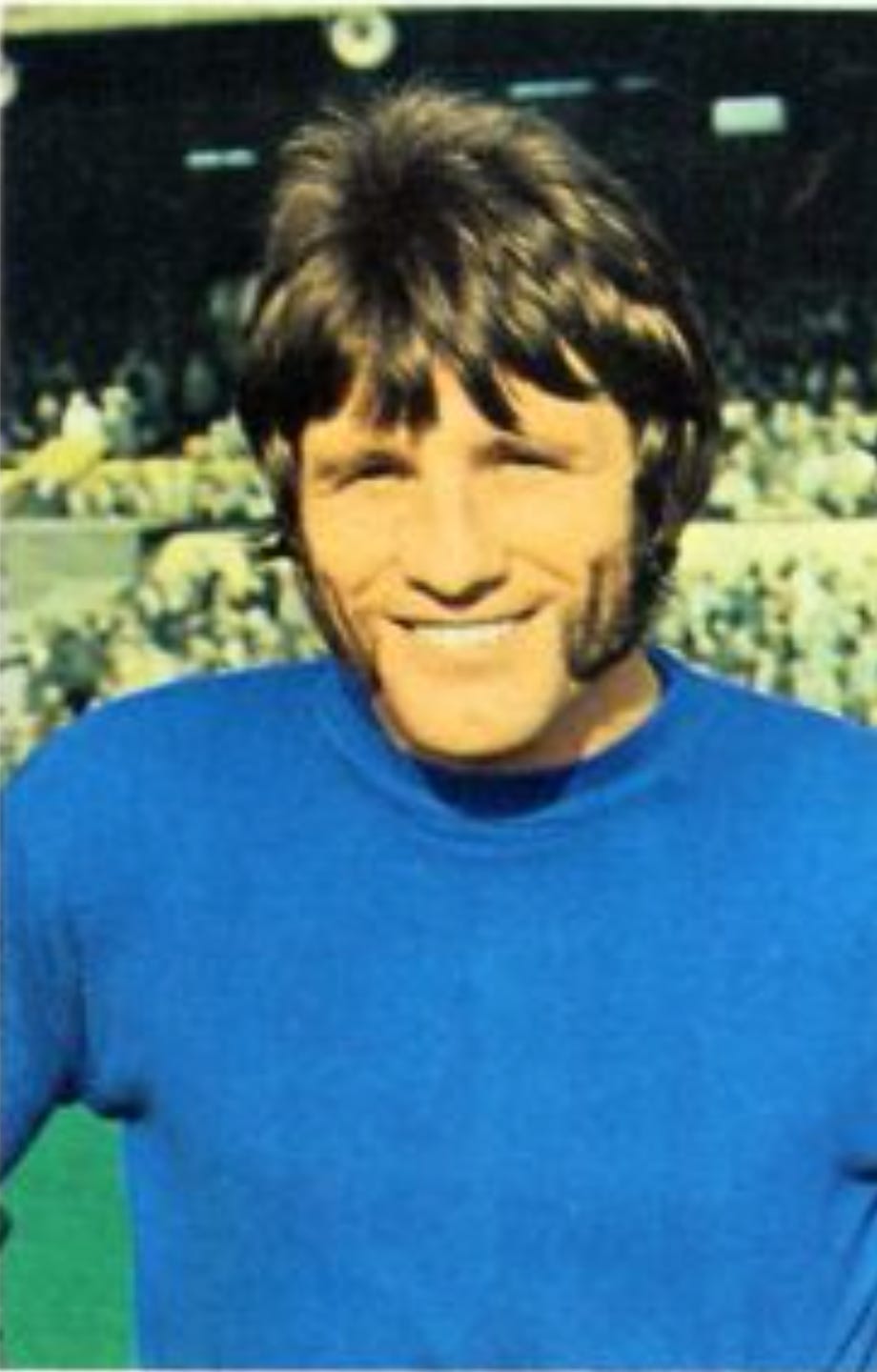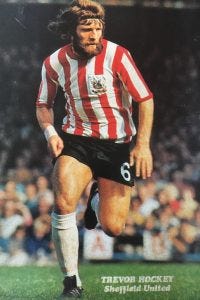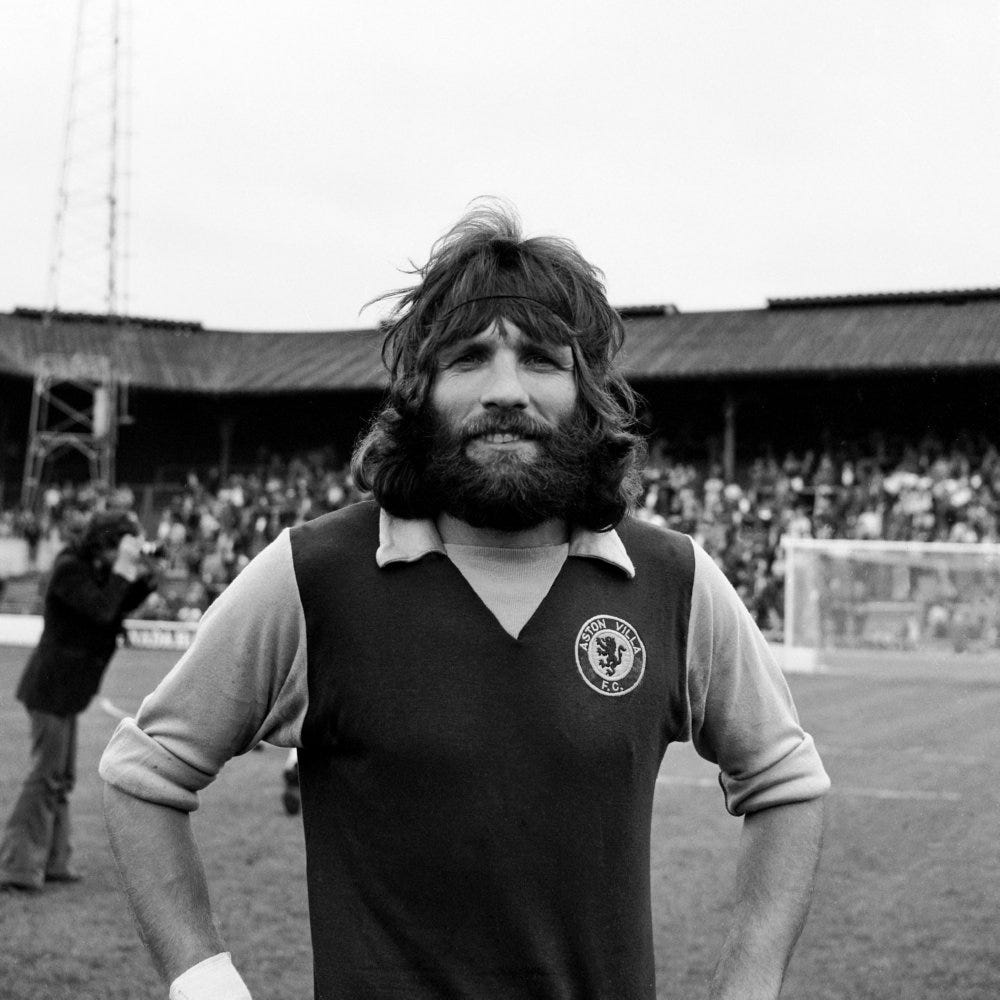The Individuals: Trevor Hockey
"A man of his time," Ian Rands tells the story of one of the most recognisable faces in Blades history.
Singing Aye Aye Hockey Hockey Aye…
Words: Ian Rands
Up and down
The story of Trevor Hockey is one of a player who moved eleven times in a seventeen-year career, leaving stylish memories with all the fans he played for. It’s a story of a player whose transformation, in terms of position, playing style and physical appearance, means that, whatever your age, on seeing a photo of Hockey at the Lane, his iconic image sticks with you.
His career started in his hometown of Keighley, playing on the wing for the local Keighley Central Youth Club, whilst gaining wider recognition in Yorkshire Schools and West Riding age-group teams. He was spotted and snapped up by Bradford City, and after playing for the reserve team while still at school, Trevor made his Bantams debut against Shrewsbury Town in 1960, while still just sixteen years old. He was highly regarded from a young age and had also starred for the Bradford youth team, with Matt Busby, then Manchester United manager, said to be sufficiently impressed to consider a bid.
The following year, aged seventeen, Nottingham Forest had seen enough to pay Bradford a club record fee of £15,000 to take him to the City Ground. Thrust straight into a relegation battle, Hockey helped his new team survive in the top flight.
After just two seasons at Forest, he was on the move again, this time dropping down a division to join Newcastle United (thereby completing the set of playing in all four divisions in just four years). After a disappointing first season, he was part of the Newcastle team that captured the Second Division title. Yet things never stayed settled for long. After three months playing for Newcastle in Division 1, it was time for yet another move and another drop down to the second tier. Birmingham City splashed out £25,000, and Trevor returned to the Midlands. Willing to drop divisions to progress his fledgling career, it was clear Hockey was a player who would never shirk a challenge: an apt assessment given what was to follow.
Getting settled
It was the mid-1960s and football was changing. Alf Ramsey’s wingless wonders highlighted a new way to play football, and Trevor’s combative style of play meant he was picked out by Blues boss Stan Cullis, not as a winger, but a central midfielder – a position he’d come to thrive in. Covering every blade of grass, supporting the attack one minute, back helping the defence the next. Energy, hard work and a willingness to get stuck in: those qualities were now more important than his wing strengths of beating opposition players with pace, power, or a trick.
He soon established a reputation as a tenacious spoiler whose job it was to fetch and carry for the flair players and tackle anything that moved. He relished it, and this led to a metamorphosis on and off the pitch. A larger-than-life personality was unleashed in all its glory. Strong enough to do his job on the pitch, securing the adulation of his own fans, and strong enough mentally to rise above the inevitable abuse of opposition supporters. Hockey revelled in the cheers and catcalls equally. He would encounter running battles with the opposition and the referee. He was one of those players you hate when he is up against your team, but a hero when he is wearing your shirt.
It was also while at St. Andrew’s that he developed the more ‘hirsute’ look that reflects the way he will be pictured by many reminiscing these days. First, an inching growth of locks and beard; then came the bushy sideburns, and eventually, the distinctive mane of hair, head band and full beard. One journalist described him as ‘tousle-haired, tenacious and terrier-like’.
Previously, Hockey had been thought of as a clean-cut and good-looking guy with a prominent dimple in his chin. It led to him having a fan club with more than a thousand members, matching the popularity of George Best, and he regularly appeared in ‘best-looking footballer’ polls in magazines. However, as Hockey became more hirsute he instead won Shoot! magazine’s poll for which footballer would make the best Father Christmas, polling 29 per cent of the vote. Nicknamed “The Beatle of Brum” he released a single, Happy ’Cos I’m Blue, bought a bright pink piano, and had a Triumph Vitesse covered in blue suede.
He was eventually made skipper at City, and his time at the Blues – spanning 231 appearances – was a success on the pitch. He helped the club to the League Cup and FA Cup semi-finals, and in 1968, reflecting his rise through the leagues, he completed the set of playing at all ninety-two grounds at the age of just twenty-five.
Hockeymania comes to Sheffield
Meanwhile, back at Bramall Lane, John Harris was early into his second spell in charge of Sheffield United and tasked with taking the Blades back to the top flight. One of United’s strongest post-war teams was being formed, with the likes of Currie, Woodward, Badger, Dearden, Colquhoun, Salmons et al. A technically gifted team, what it lacked, surprisingly for a Sheffield side, was a bit of steel in the middle of the pitch and Harris knew exactly who could provide it. In January 1971, a bid of £40,000 saw John Harris secure Hockey’s move to Bramall Lane with the Blades already in a strong position to achieve that return to the First Division.
His arrival caused a stir. Len Badger said at the time:
“I always remember the day he came, he turned up in this velvet car, carrying an umbrella …he turned out to be the hardest man I ever played with”.
Geoff Salmons said:
“We were all made to wear collar and tie in those days under John Harris and Hockey turned up in a leather jacket and polo neck sweater for his signing. Mr Harris was crafty, he signed him and then told him about our dress rules”.
The Battler of Bramall Lane
Playing alongside Tony Currie, Hockey was tasked by Harris with one simple objective: “Battle, win the ball and give it to Currie” who would work his magic. And that he did, showing the tenacity and battle-hardiness appreciated by Blades fans. His arrival was one of the key enablers for the Blades succeeding in their objective of promotion.
The images I remember seeing of Hockey in United programmes and books growing up created a bit of a misconception in my mind, and maybe in those of others who never saw him play. The hair, the headband, the bushy beard that filled his headshot; they created an image of a man mountain, a player who might physically impose himself on the opposition. The reality was quite different; he was diminutive, around 5’ 6”, but with plenty more character and physicality than his frame suggested possible. The journalist’s description of him as terrier-like reflected his height differential.
His role was not about personal glory. In his time at United he scored just four goals; however, the first of those four goals was vital, cheeky and a little fortuitous. United came into the home game versus Millwall in mid-April on the back of three nil-nil draws, the previous game being the Sheffield derby at Hillsborough. With less than ten minutes to go, United looked likely to continue their scoreless streak; the promotion bid was faltering. The Blades had been well on top but unable to break down a stubborn Millwall defence.
Lions keeper Bryan King held a cross from a corner and was about to boot the ball upfield. All the players were running back to their positions except for Hockey, who ran and dived towards the keeper, used his hands to knock the ball out of King's hands, and slid across to force the loose ball into the net. Some in the crowd laughed at the cheekiness for a second or two, Billy Dearden ran over to congratulate Hockey and the referee, presumably thinking there had been a collision or loose hands from King, awarded the goal. Furious Millwall players immediately surrounded him, but the goal stood, and United sealed an important win in injury time. They went on to win three and draw one of their final four games, scoring twelve goals and sealing promotion with a 3-0 victory over Watford on the final day of the season.
Final flourishes
With rule changes allowing players to represent the country of their parents’ birth, Wales identified Hockey as a worthy addition to their ranks. His dad was a Welsh Rugby Union player but was playing the other Rugby code in West Yorkshire when Trevor was born. The Yorkshireman made his Wales debut in October 1971 in a 3-0 win over Finland at Wrexham, with Blades teammate Gil Reece on the scoresheet. Going on to make nine appearances for his adopted country, his only goal came against Poland in a World Cup qualifier in Cardiff in 1973, scoring past Jan Tomaszewski - the goalkeeper termed “a clown” by Brian Clough, but who went on to be the man who kept out England at Wembley and deny Don Revie’s team a trip to the World Cup in Germany. Hockey also got sent off playing for Wales in Poland on what proved to be his final international appearance, the first Welsh international to see red. An ignominious stain on an otherwise spotless career.
Off the pitch, he was just as popular at Bramall Lane as he had been at St Andrews, recognising the good fortune his skills had given him, always taking the time to chat with supporters and sign autographs, but happily playing up to the ‘bad-boy’ role he had been cast as by the press. He still had the Triumph Vitesse and lived in a semi-detached house on Jowitt Road off Bannerdale – young fans targeted Hockey, Len Badger and Billy Dearden (who all lived close by) on Bob-a-Job week, but unsurprisingly he wouldn't let them wash his car. He was just as liked by the media as well, appearing on Yorkshire TV’s Calendar News programme playing the piano, although not his pink one.
Hockey remained an integral part of the United team in Division 1, but in a February 1972 match with Manchester City, Hockey suffered a broken leg in a clash with Mike Doyle. Hockey gingerly got to his feet and ran around briefly before collapsing to the ground and being helped off the pitch by United trainer Cec Coldwell. The injury effectively ended his time at the Lane. He made his final appearance in a Blades shirt on 30th December 1972 in a 4-1 defeat at St. James’ Park.
Beyond Bramall Lane
A swap deal in February 1973 saw Jimmy Bone, the Scottish striker, move from Norwich to Bramall Lane, with Hockey heading to Carrow Road. Neither move was a long-term success, but Hockey did what he was brought in to do, adding steel to the Canaries’ midfield and helping keep the newly-promoted side in the top flight.
Injuries were starting to take their toll, and six months after joining Norwich City he moved to Aston Villa where he was limited to just 24 appearances. His next move took him back to where it had all begun, Bradford City. Once again, playing time was limited. He had not been the same player after breaking his leg, and the injuries that blighted the remainder of his career must have been linked to that Doyle tackle.
A brief trip to Ireland followed in March 1976, Hockey taking on the role of player-manager at Athlone Town. Later that year, he crossed the Atlantic, joining the San Diego Jaws in their inaugural season in the North American Soccer League (NASL), subsequently playing and coaching in Las Vegas and San Jose. The NASL was going through its 1970s boom period, attracting big-name players, often in the twilight of their careers. At San Jose, Hockey lined up alongside Eusebio, with both facing up against New York Cosmos and Pele. He returned to England, playing a handful of matches for Ashton United in the Northern Premier League before finally hanging up his boots.
The End
Hockey moved back to his hometown with the ambition of building up a Keighley team that would be able to compete in the Northern Premier League. That dream remained unfulfilled, with success on the pitch negated by ground grading issues off it. He was incredibly well thought of in Keighley, working with local soccer schools and coaching camps. He also spent some time as landlord of a local pub, The Lord Rodney, which was furnished with memorabilia from his career. He continued to coach and play, but sadly the game he loved was a contributory cause of his passing. Hockey never recovered from a heart attack that he suffered after taking part in a five-a-side tournament in Keighley in 1987. He died aged just 43.
In the first Blades home game after he died, United played Blackburn Rovers – a rare high-scoring victory in the Billy McEwan era. The back of the Kop chanted slowly, like a lament, throughout the game:
"Singing Aye Aye Hockey Hockey Aye"
Some players don’t require long at a club to leave a lasting impression, not just on opponents’ shins, but on the fans who turn up every week. The fan appreciation of Trevor Hockey might not have developed as a result of his ability, his battling role perhaps limiting the visibility of some of the more skilful aspects of his game. However, he displayed a combination of characteristics always appreciated by the Bramall Lane faithful: a physical style of play and a willingness to put it all on the line for the team. Throw in his sense of style, his appearance, and a warm, willing relationship with supporters off the pitch, and it was a perfect recipe for success.
“Trevor had this reputation as a hard man, but he never gave me a bit of trouble. The lads all loved him, and he was one of the best signings I made. A man of his time; just what I wanted.”
John Harris
Ian Rands is a former blogger at the FSF Awards nominated ‘A United View’. He has contributed to books, magazines and newspapers, alongside his day job away from writing. Now a quarter of the Four Blades in the Pub podcast, he has been following the Blades for more than 40 years, the last 33 of which as a Kop season ticket holder.






Lovely to read about Trevor Hockey.....thank you for the memories. I watched him play alongside Tony Currie, Len Badger etc etc....the dream team. He was flamboyant and great to watch and my friends and I all loved him👍 so sad he died so young but a Yorkshireman playing for my country, Wales doesn't get much better than that!
That’s a great piece Ian, Trevor Hockey is one of my all time favourites, absolutely ran his socks off, he would tackle anybody, Jack Charlton and you mentioned Mike Doyle, proper hard players. He just relished the challenge Hockey really did the donkey work and he had skill. A legend in my eyes. I once saw his Vitesse parked on Leopold Street in Sheffield, Near the Buccaneer club. The car was worse for wear .
That 71 side really could destroy anyone on their day. Thanks for some great memories 👍🏻⚔️
Brian